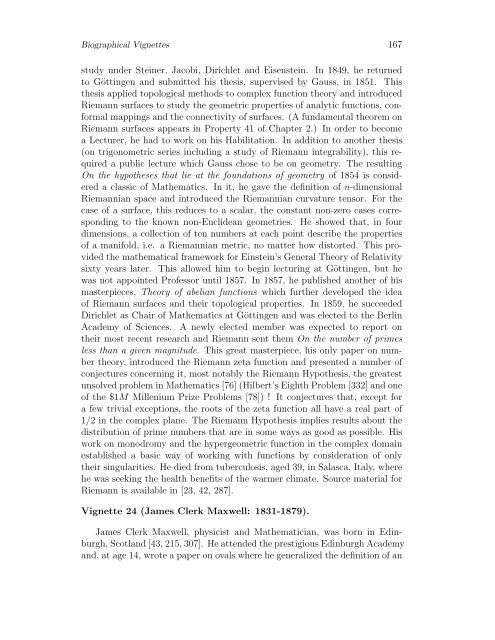MYSTERIES OF THE EQUILATERAL TRIANGLE - HIKARI Ltd
MYSTERIES OF THE EQUILATERAL TRIANGLE - HIKARI Ltd
MYSTERIES OF THE EQUILATERAL TRIANGLE - HIKARI Ltd
Create successful ePaper yourself
Turn your PDF publications into a flip-book with our unique Google optimized e-Paper software.
Biographical Vignettes 167<br />
study under Steiner, Jacobi, Dirichlet and Eisenstein. In 1849, he returned<br />
to Göttingen and submitted his thesis, supervised by Gauss, in 1851. This<br />
thesis applied topological methods to complex function theory and introduced<br />
Riemann surfaces to study the geometric properties of analytic functions, conformal<br />
mappings and the connectivity of surfaces. (A fundamental theorem on<br />
Riemann surfaces appears in Property 41 of Chapter 2.) In order to become<br />
a Lecturer, he had to work on his Habilitation. In addition to another thesis<br />
(on trigonometric series including a study of Riemann integrability), this required<br />
a public lecture which Gauss chose to be on geometry. The resulting<br />
On the hypotheses that lie at the foundations of geometry of 1854 is considered<br />
a classic of Mathematics. In it, he gave the definition of n-dimensional<br />
Riemannian space and introduced the Riemannian curvature tensor. For the<br />
case of a surface, this reduces to a scalar, the constant non-zero cases corresponding<br />
to the known non-Euclidean geometries. He showed that, in four<br />
dimensions, a collection of ten numbers at each point describe the properties<br />
of a manifold, i.e. a Riemannian metric, no matter how distorted. This provided<br />
the mathematical framework for Einstein’s General Theory of Relativity<br />
sixty years later. This allowed him to begin lecturing at Göttingen, but he<br />
was not appointed Professor until 1857. In 1857, he published another of his<br />
masterpieces, Theory of abelian functions which further developed the idea<br />
of Riemann surfaces and their topological properties. In 1859, he succeeded<br />
Dirichlet as Chair of Mathematics at Göttingen and was elected to the Berlin<br />
Academy of Sciences. A newly elected member was expected to report on<br />
their most recent research and Riemann sent them On the number of primes<br />
less than a given magnitude. This great masterpiece, his only paper on number<br />
theory, introduced the Riemann zeta function and presented a number of<br />
conjectures concerning it, most notably the Riemann Hypothesis, the greatest<br />
unsolved problem in Mathematics [76] (Hilbert’s Eighth Problem [332] and one<br />
of the $1M Millenium Prize Problems [78]) ! It conjectures that, except for<br />
a few trivial exceptions, the roots of the zeta function all have a real part of<br />
1/2 in the complex plane. The Riemann Hypothesis implies results about the<br />
distribution of prime numbers that are in some ways as good as possible. His<br />
work on monodromy and the hypergeometric function in the complex domain<br />
established a basic way of working with functions by consideration of only<br />
their singularities. He died from tuberculosis, aged 39, in Salasca, Italy, where<br />
he was seeking the health benefits of the warmer climate. Source material for<br />
Riemann is available in [23, 42, 287].<br />
Vignette 24 (James Clerk Maxwell: 1831-1879).<br />
James Clerk Maxwell, physicist and Mathematician, was born in Edinburgh,<br />
Scotland [43, 215, 307]. He attended the prestigious Edinburgh Academy<br />
and, at age 14, wrote a paper on ovals where he generalized the definition of an

















